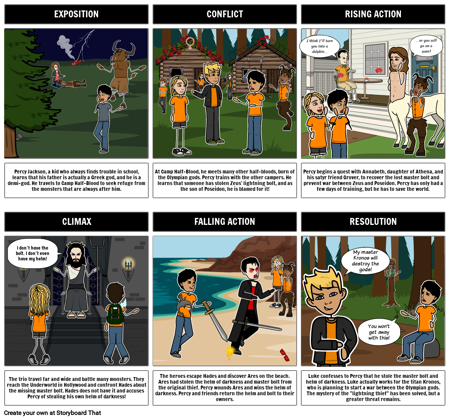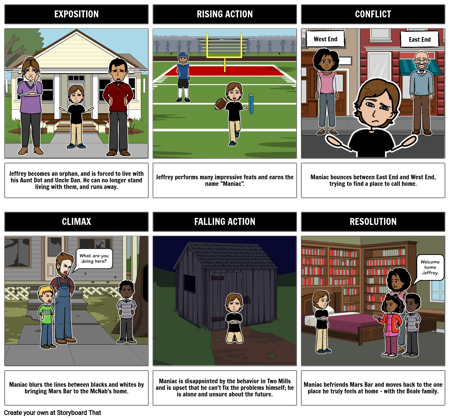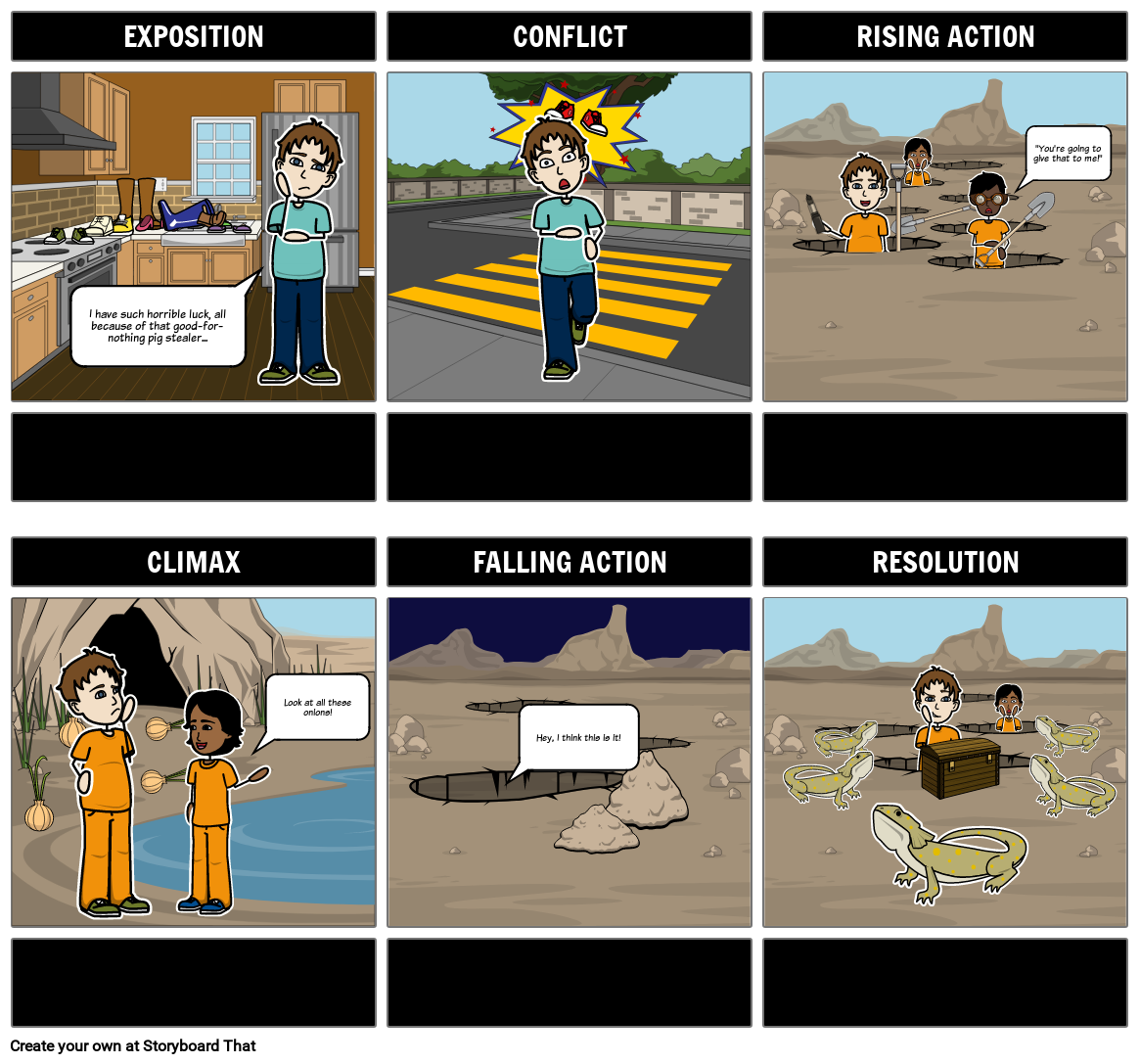The Three Parts of a Reading Plot Mountain
Narrative arcs and the "Plot Diagram" are essential for building literary comprehension and appreciation. Plot diagrams allow students to choice out major themes in the text, trace changes to major characters over the course of the narrative, and hone their analytic skills. Lessons emphasizing these skills meet many Common Cadre Standards for English Linguistic communication Arts (CCSS.ELA-Literacy). The concepts not only give students a fuller agreement of classroom texts, merely also their favorite books and movies.
Elements of Plot Structure
Exposition
The exposition is the introduction to a story, including the master characters' names, setting, mood, and time.
Conflict
The conflict is the primary problem that drives the plot of the story, often a main goal for the protagonist to attain or overcome.
Rising Action
The rising action of the story is all of the events that lead to the eventual climax, including graphic symbol development and events that create suspense.
Climax
The climax is the virtually exciting betoken of the story, and is a turning betoken for the plot or goals of the chief character.
Falling Action
The falling action is everything that happens as a result of the climax, including wrapping-upwardly of plot points, questions beingness answered, and character development.
Resolution
The resolution is not ever happy, but it does complete the story. It can leave a reader with questions, answers, frustration, or satisfaction.
Past plotting simple narrative arcs in three-cell storyboards, or more complicated stories in 6-cell boards, teachers tin hands assess students' understanding of important story components. Combined illustrations and text can enliven difficult concepts like "rise activeness" and "climax".

Example Plot Diagram Activities
Plot diagrams tin can be completed with whatsoever novel across form levels. View some of the premade plot diagram activities you can copy to your teacher business relationship. For younger students or shorter books, replace the plot diagram with a Beginning, Centre, Terminate summary.
Plot Diagram Template
Making storyboards that explain a plot bring students' agreement to life! Information technology'southward an engaging and fun mode for students to interact with the texts they read in class. The details and characters featured in students' storyboards permit instructors to immediately decide whether students comprehend the scope of the objectives. For narrative arcs for younger grades or other plot diagram templates, make sure to check out "Four Innovative Ways to Teach Parts of a Story".

Plot Diagram Examples from Literature


Suggested Modifications
For the Students Who Need Minimal Guidance
Within special instruction there are varying degrees of abilities, including students who may have disabilities that take a minimal impact on their cerebral abilities. Those students for whatever reason may still be in a special education setting only won't necessarily demand significant modifications on something like a plot diagram.
For the students that crave minimal assistance, a blank plot diagram with very little or no data completed may be best. As the creator of the storyboard, the teacher can control just what data is provided and decide how much to guide students. Use the templates higher up as they are, or make slight adjustments to the templates.
Students Who Need a Piffling Guidance
Some students will need a petty more guidance when it comes to a plot diagram. Students who struggle with reading comprehension may have difficulty picking out the different parts of a story. Details of the story can be lost in translation, then to speak.
That is where a plot diagram with some leading data can be helpful. Providing visuals prior to asking the students to complete the plot diagram gives them "clues" to what they are looking for when completing the diagram. The visuals act as context clues for students to focus their free energy on the advisable information, equally seen in the Holes Plot Diagram.

Students Who Demand More Guidance
Storyboarding allows for variations that besides work for those students who really struggle and require more explicit guidance. For students who can still complete the plot diagram as an consignment but demand simplification, alter the plot diagram to a more than basic "outset middle end" approach. With the BME storyboard the amount of data included can nonetheless be every bit little or as much as needed for the students. Check out BME storyboard templates and examples already completed and ready for use.
A completed plot diagram storyboard may be better if BME does not fit the assignment and the students require a more in-depth plot diagram. The students tin can and then utilize it as a reference rather than an assignment. Options similar this are smashing, especially when the students notice what other students have or don't have. From afar, information technology will expect like they received the same storyboard, but they really have i that meets their needs.

Classroom Exercises and Book Reports
Some fun ways to teach this lesson using Storyboard That:
- Have students illustrate exposition, rising action, disharmonize, climax, falling action, and resolution, in a six-cell storyboard.
- Every bit office of editing, have students diagram their ain creative writing to find major plot points.
- Put an empty storyboard on an assessment, and crave students to illustrate the plot points of a class text.
Relating to the Mutual Cadre
Analyzing a literary work with a plot diagram fulfills Mutual Core ELA standards for many age groups. Below are just two examples of ELA standards for different levels. Please run across your Common Core State Standards for grade-appropriate strands.
- ELA-Literacy.RL.9-ten.2: Determine a theme or central thought of a text and analyze in detail its development over the course of the text, including how it emerges and is shaped and refined by specific details; provide an objective summary of the text
- ELA-Literacy.RL.6.iii: Describe how a particular story'due south or drama's plot unfolds in a series of episodes as well as how the characters answer or change as the plot moves toward a resolution
Example Rubrics
| Proficient 33 Points | Emerging 25 Points | Beginning 17 Points | |
|---|---|---|---|
| Design | Each cell includes a artistic heading. Cells include images that help to tell the story and do not hinder agreement. | A cell is missing a heading, or headings are completely unrelated to the diagrammed piece of work. | Cells have no headings. |
| Plot | There are three cells. Each one represents a different role of the story. The cells are in gild from starting time to end. | Cells are out of guild. | Ane or more of the cells is missing |
| Spelling and Grammar | Spelling and grammar is by and large accurate. Mistakes do not hinder agreement. | Spelling is very inaccurate and hinders total understanding. | Cells cannot be understood. |
| Proficient 33 Points | Emerging 25 Points | Commencement 17 Points | |
|---|---|---|---|
| Design and Artistic Elements | Creativity and imagery are used effectively (helps to tell the story). At least iii Textables are included in plot diagram. | Creative elements (clipart) are somewhat distracting. At to the lowest degree two Textables throughout their plot diagram. | Creativity is minimally apparent, and the overall design shows a lack of effort. Clipart may be confusing and distract from the story. Student used one or fewer Textables. |
| Spelling and Grammar | Spelling within the Textables is mostly correct (fewer than eight errors). Grammar does not hinder understanding. | Spelling within textables is somewhat correct (fewer than 10 errors). Grammer may hinder some understanding or make reading difficult. | Spelling is mostly incorrect (ten or more errors). Grammar severely hinders understanding. |
| Plot Elements | At that place are three complete slides: one for beginning, one for the middle, and one for the end. Slides explicate the piece of work of prose and are piece of cake to follow. | There are three cells, but 1 or 2 do not describe the correct element within the work of prose (east.g. the beginning is misplaced). Story is somewhat difficult to follow. | One or more cells is missing. Merely one part of the plot is represented (e.g. only the get-go). Story is hard to follow. |
Create a plot diagram for the story using Exposition, Disharmonize, Rising Action, Climax, Falling Activity, and Resolution.
| Proficient 25 Points | Emerging 21 Points | Beginning 17 Points | Endeavor Again 13 Points | |
|---|---|---|---|---|
| Descriptive and Visual Elements | Cells have many descriptive elements, and provide the reader with a brilliant representation. | Cells have many descriptive elements, only catamenia of cells may have been hard to understand. | Cells have few descriptive elements, or take visuals that brand the work confusing. | Cells accept few or no descriptive elements. |
| Grammer/Spelling | Textables have three or fewer spelling/grammar errors. | Textables take 4 or fewer spelling/grammar errors. | Textables have 5 or fewer spelling/grammer errors. | Textables have vi or more spelling/grammar errors. |
| Evidence of Effort | Piece of work is well written and carefully thought out. Student has done both peer and teacher editing. | Work is well written and carefully thought out. Pupil has either teacher or peer editing, just non both. | Student has done neither peer, nor teacher editing. | Work shows no evidence of any effort. |
| Plot | All parts of the plot are included in the diagram. | All parts of the plot are included in the diagram, only i or more is confusing. | Parts of the plot are missing from the diagram, and/or some aspects of the diagram make the plot difficult to follow. | Nigh all of the parts of the plot are missing from the diagram, and/or some aspects of the diagram make the plot very difficult to follow. |
Customize Worksheets!
If y'all're looking for another step or an alternative consignment, yous tin can create plot diagram worksheets to use in your class! These worksheets tin be customized and printed out for students to make full out with a pencil, or they can exist completed in the Storyboard Creator similar a digital worksheet. You can even create multiple versions for those students who might need a little extra assistance, and continue them on mitt for future utilize! Notice plenty of templates to work from or just start with a blank canvas.
Source: https://www.storyboardthat.com/articles/e/plot-diagram
0 Response to "The Three Parts of a Reading Plot Mountain"
Post a Comment